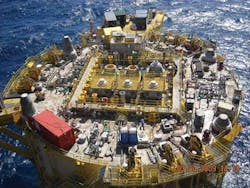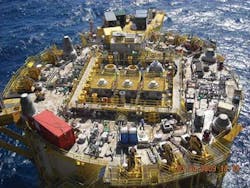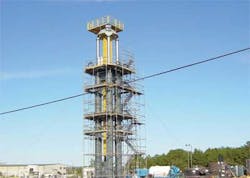Riser System at Perdido Features Newest GE Oil & Gas Tensioners
Top-tensioned production, drilling risers only alternative for record deepwater truss spar installation over DVA wells
In the post-Katrina/Rita Gulf of Mexico hurricane era, new met ocean criteria and acceptance requirements for “100-year and 1000 year” events calls for both new and improved elements to be incorporated into the design of deepwater drilling and production equipment.
Because the spar is the industry’s deepwater and ultra-deepwater floating production platform of choice, new changes are being made in the tensioning and motion compensation hardware necessary to stabilize risers on spars against heavy storm wave and wind forces. One such progression involves the choice of ram-type, or “push-up” tensioners for top-tensioned vertical production and drilling/workover risers. Shell Exploration & Development’s Perdido Regional Development Spar is equipped with this type of riser tensioning equipment supplied by GE Oil & Gas (formerly GE Vetco Gray).
Perdido spar riser tensioners in various stages of installation prior to installation of the topsides. The six tensioners are in two rows in the center square of the spar deck. The three units on the bottom row are installed complete and stroked down (closed) awaiting commissioning. The remaining units on the top row are in various stages of installation.
From the beginning Shell, as operator for BP and Chevron, planned to employ a direct vertical access (DVA) configuration at the Perdido spar’s host location in the Great White field in order to bring oil and natural gas production from the field’s subsea wet tree wells to the spar’s topsides for subsequent handling and export back to shore. This would be the first such DVA setup to be installed on a truss-type spar.
Top-tensioned risers were essential for the Perdido spar, at a record depth of some 7,820 ft (2,384m) from spar topsides to the sea floor. Buoyancy can tensioned risers employed on spar platforms in much shallower water would have been impracticable.
Additionally, instead of having a riser and dry tree for each well, the spar would be equipped with only six risers – five pipe-in-pipe risers for handling production from multiple subsea wells and one high-pressure riser for drilling and completions. Instead of being connected with individual wells, the production risers would be connected to five seafloor caisson/electric submersible pump (ESP) boosting stations that would handle flow from 22 subsea DVA wells and 11 subsea offset wells. In addition to increased efficiency due to lighter weight, having only six risers would help keep the spar’s topsides decks smaller and thus, less capital intensive.
The single, high-pressure DVA drilling riser would be used to allow a topside-mounted rig to drill, complete and to perform interventions on wells at significantly lower cost than employing deepwater mobile rigs for such purposes. In addition, the topside rig would use this riser to gain access to the seafloor booster stations for possible change-out of ESP equipment, should that become necessary.
First offshore installation
Six GE Oil & Gas hydraulic/pneumatic tensioners were installed to support the risers aboard the Perdido spar. The installation was made at the spar’s offshore site rather than the conventional installation at a shore base prior to float-out. This was the first time such a remote offshore ram riser tensioner installation has been made.
In general, riser tensioners are designed to provide the necessary interface to support riser weight and to compensate for relative motion due to spar offset, heave, thermal expansion, payload changes and subsidence. A typical MODU drilling riser tensioner consists of a hydraulic cylinder with sheaves at both ends. The cylinder is connected to a number of high-pressure gas bottles, or accumulators, via a medium separator. A wire rope is rigged in the cylinder with one end connected to the fixed part of the tensioner and the other end is connected to the riser.
Top-tensioned risers connected directly to the spar hull provide a range of stiffness at the hang-off point. This stiffness variation provides a tradeoff between riser stroke relative to the hull and the tension on the riser, and combined with lower operating costs, are the practical alternative to buoyancy can-supported riser systems.
The GE Oil & Gas ram-type riser tensioner configuration uses multiple (four) hydro-pneumatic compression cylinders that employ efficient, low-fluid volume to allow for large internal accumulator volumes that, depending upon the application, minimize the requirement for external accumulators while providing for the required range of stiffness. Combined with durable construction and relative low accumulator pressures, the GE Oil & Gas tensioners help reduce risk elements and increase tensioner life. Being small in footprint versus their capacity, they also allow for more available topsides deck space.
Each of the GE Oil & Gas tensioners is equipped with four hydro-pneumatic cylinders, each operating independent of the other but combined, constitute a “team.”. Should trouble be experienced with any one cylinder, it can be easily removed and either repaired at the site or sent to shore. Meanwhile, as evidenced by testing under load at GE’s Houston manufacturing center, the remaining three cylinders are capable of holding sufficient tension to continue required motion compensation.
Coating reliability enhanced
To help meet Shell’s 25-year lifespan design requirement and provide high reliability in a corrosive environment, the rods of the Perdido spar riser tensioners are protected with a newly developed coating that virtually eliminates the threat of degradation by acids contained in oilfield chemicals.
Tensioner pressure feedback is monitored and adjusted with equipment located in the Spar topsides control room.
Significant to its continued innovation and development of new hardware, GE Oil & Gas riser tensioner technology was a finalist for the Woelfel Best Mechanical Engineering Achievement Award at the 2009 Offshore Technology Conference.
GE Oil & Gas
4424 W. Sam Houston Parkway North
Suite 100
Houston, Texas 77041
Tel: 281-448-4410
Website: www.geoilandgas.com



